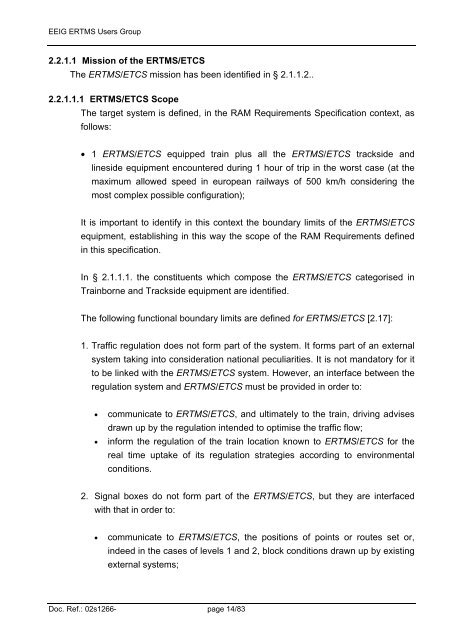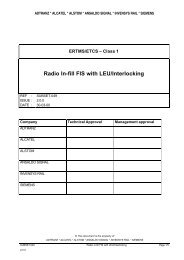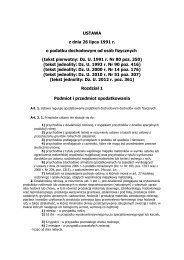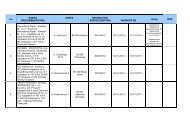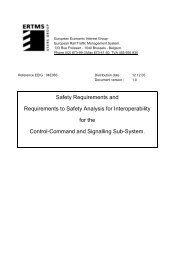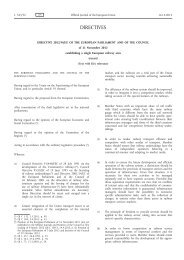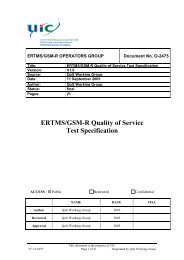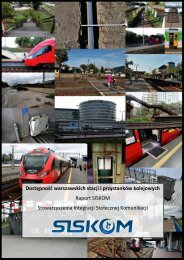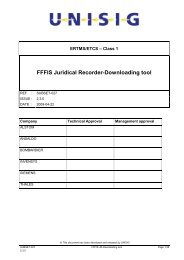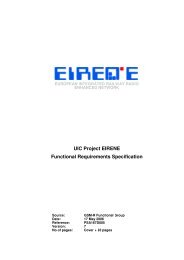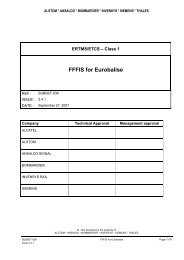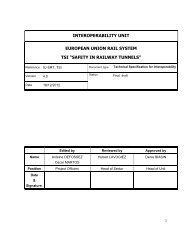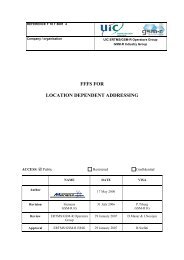ERTMS/ETCS RAMS Requirements Specification Chapter 2 - RAM
ERTMS/ETCS RAMS Requirements Specification Chapter 2 - RAM
ERTMS/ETCS RAMS Requirements Specification Chapter 2 - RAM
- No tags were found...
Create successful ePaper yourself
Turn your PDF publications into a flip-book with our unique Google optimized e-Paper software.
EEIG <strong>ERTMS</strong> Users Group2.2.1.1 Mission of the <strong>ERTMS</strong>/<strong>ETCS</strong>The <strong>ERTMS</strong>/<strong>ETCS</strong> mission has been identified in § 2.1.1.2..2.2.1.1.1 <strong>ERTMS</strong>/<strong>ETCS</strong> ScopeThe target system is defined, in the <strong>RAM</strong> <strong>Requirements</strong> <strong>Specification</strong> context, asfollows:• 1 <strong>ERTMS</strong>/<strong>ETCS</strong> equipped train plus all the <strong>ERTMS</strong>/<strong>ETCS</strong> trackside andlineside equipment encountered during 1 hour of trip in the worst case (at themaximum allowed speed in european railways of 500 km/h considering themost complex possible configuration);It is important to identify in this context the boundary limits of the <strong>ERTMS</strong>/<strong>ETCS</strong>equipment, establishing in this way the scope of the <strong>RAM</strong> <strong>Requirements</strong> definedin this specification.In § 2.1.1.1. the constituents which compose the <strong>ERTMS</strong>/<strong>ETCS</strong> categorised inTrainborne and Trackside equipment are identified.The following functional boundary limits are defined for <strong>ERTMS</strong>/<strong>ETCS</strong> [2.17]:1. Traffic regulation does not form part of the system. It forms part of an externalsystem taking into consideration national peculiarities. It is not mandatory for itto be linked with the <strong>ERTMS</strong>/<strong>ETCS</strong> system. However, an interface between theregulation system and <strong>ERTMS</strong>/<strong>ETCS</strong> must be provided in order to:• communicate to <strong>ERTMS</strong>/<strong>ETCS</strong>, and ultimately to the train, driving advisesdrawn up by the regulation intended to optimise the traffic flow;• inform the regulation of the train location known to <strong>ERTMS</strong>/<strong>ETCS</strong> for thereal time uptake of its regulation strategies according to environmentalconditions.2. Signal boxes do not form part of the <strong>ERTMS</strong>/<strong>ETCS</strong>, but they are interfacedwith that in order to:• communicate to <strong>ERTMS</strong>/<strong>ETCS</strong>, the positions of points or routes set or,indeed in the cases of levels 1 and 2, block conditions drawn up by existingexternal systems;Doc. Ref.: 02s1266- page 14/83


